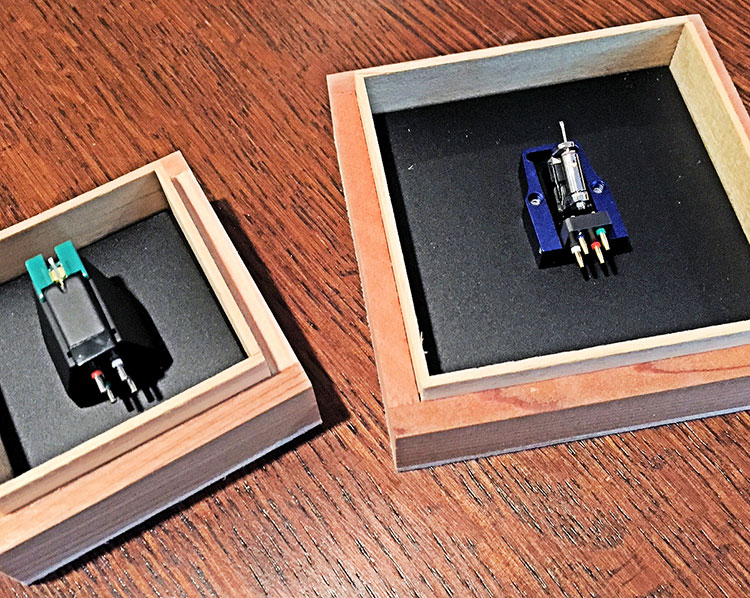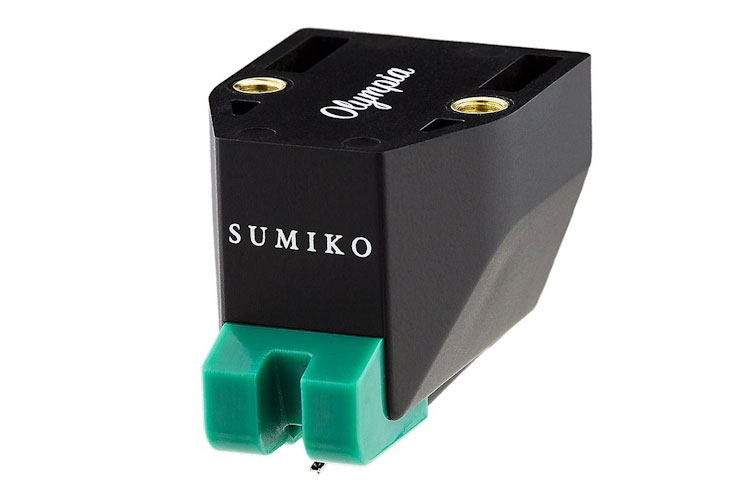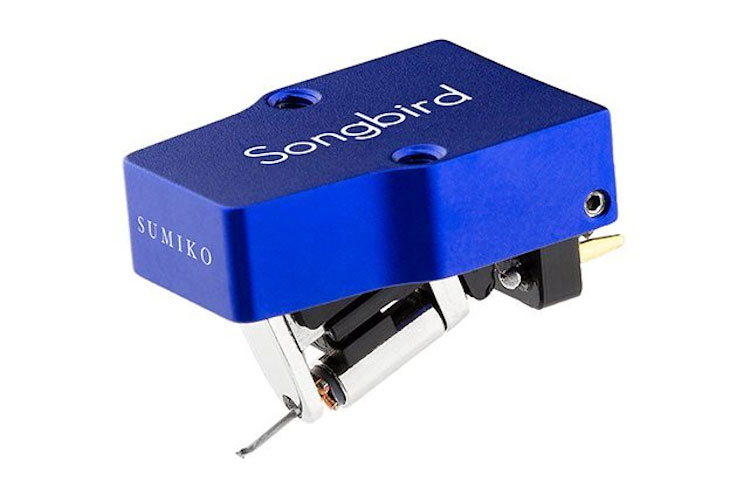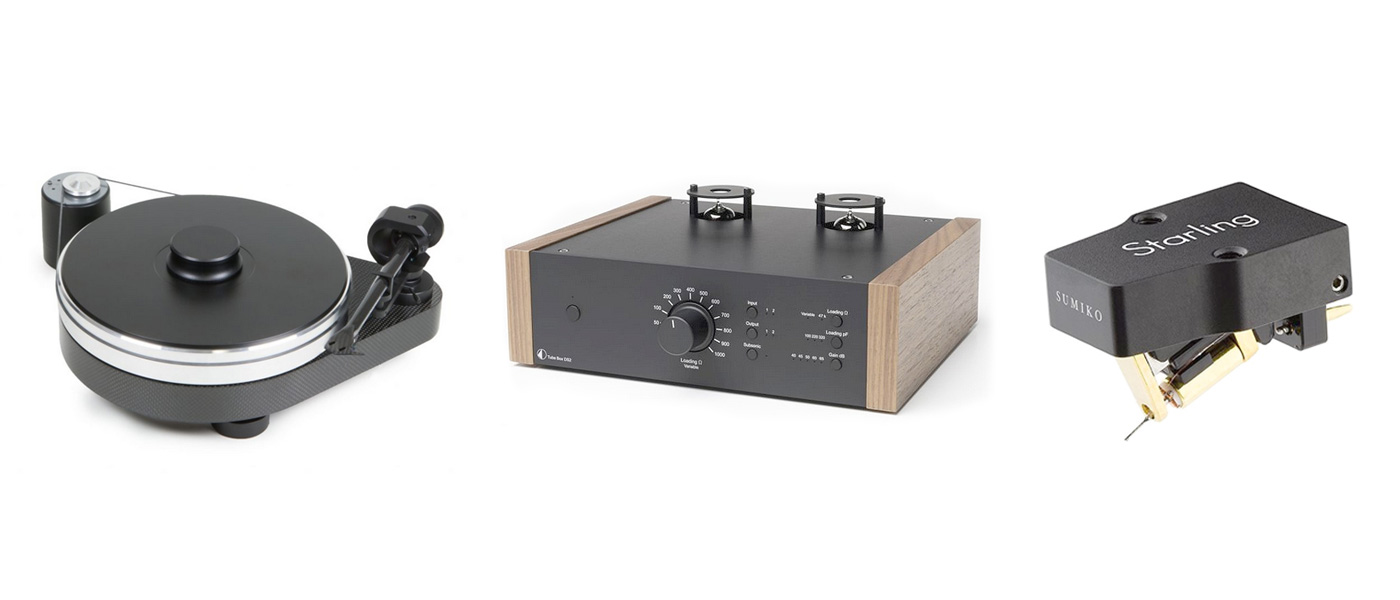
Sumiko Olympia Oyster Series and Songbird Reference Series Phono Cartridges
- Standard load impedance easy for most phono stages
- Replaceable stylus on the Olympia
- High Output
- Easy, no nuts mounting
- Warm, neutral sound
The phono cartridge is as utilitarian as can be; the needle traces the grooves in a record, translates the vibrations into audio signals and shares that information with a preamplifier.
Cartridge Type:
Moving Magnet
Stylus:
0.3 x 0.7 micron Elliptical
Cantilever Material:
aluminum
Wire Material:
copper
Internal Impedance:
1,130Ω
Load Impedance:
47kΩ
Frequency Response:
12Hz – 30kHz
Output Voltage:
4mV @ 1kHz
Channel Separation:
30dB @ 1kHz
Channel Balance:
1.5dB @ 1kHz
Compliance:
12×10-6 cm/dyn @ 100Hz
Recommended Load Capacitance:
100pF – 200pF
Vertical Tracking Angle:
20°
Tracking Force:
1.8g – 2.2g
Recommended Force:
2.0g
Cartridge Weight:
6.5g
M.S.R.P:
$199.00
Cartridge Type:
Moving Coil
Stylus:
0.3 x 0.7 micron Elliptical
Cantilever Material:
coated aluminum pipe
Wire Material:
pure copper
Internal Impedance:
135 Ohms
Load Impedance:
47kΩ
Frequency Response:
12Hz – 40kHz
Output Voltage:
2.5mV
Channel Separation:
30dB @ 1kHz
Channel Balance:
<0.5dB @ 1kHz
Compliance:
12×10-6 cm/dyn @ 100Hz
Recommended load capacitance:
100pF – 200pF
Vertical tracking angle:
20°
Tracking Force:
1.8g – 2.2g
Recommended Force:
2.0g
Cartridge Weight:
8.5g
M.S.R.P.:
$899.00
Company:
SECRETS Tags:
phono cartridge, MC, MM, stylus, Cartridge Review 2018, Sumiko Olympia Oyster Series
But I find the variations in phono cartridge design fascinating, in fact I’d call them small pieces of art made from varying materials, woods and metals.
Secrets Sponsor
Cartridges also come at all price points, from under $100 to several thousand, why the significant difference for something so simple? That may be harder to define, especially in the price-to-performance debate. But what is the most important issue here; the phono cartridge is the most significant aspect affecting the sound quality of your records, period. It doesn’t matter what speakers or amplifiers you have, if the cartridge doesn’t do its work well, expect poor sound quality.
Sumiko recently announced six new cartridges to add to their extensive line of Reference and Oyster Series. I remember, (never owning) their Blue Point MC cartridge setting a standard for price and performance of which several iterations exist and are still available. I digress. From the new cartridges introduced, I asked for an MC cartridge and an MM as well. They sent me the Olympia (MC) in the Oyster Series and the Songbird (MM) from the Reference Series.
Both cartridges come beautifully boxed in a wood container with supplied wrench and screw mounts.

The value-priced Olympia at $199.00 represents the middle of the extensive Oyster Series. This 6.5g moving magnet cartridge features an aluminum cantilever and 0.3 x 0.7 micron elliptical stylus with a recommended 2.0g tracking force. A frequency response from 12Hz-30kHz and output voltage of 4mV @ 1kHz. If in the future you want to upgrade, do so by just replacing the stylus like the Sumiko Moonstone.

The $899.00, high output, moving coil Songbird represents the entry level of their Reference Series, topping out with the Palo Santos Presentation which sells for $4,499.00. The Songbird weighs more than the Olympia at 8.5g with a similar 2.0g tracking force and an output voltage of 2.5mV. Frequency response is listed slightly wider between 12Hz-40kHz but both share the same load impedance of 47kHz.
My current setup includes a Clearaudio Virtuoso MM cartridge on a Marantz TT-15S1 Reference turntable. A Parasound JC3 Jr as my phono stage fed through to a Parasound P5 preamplifier and A21 amplifier. On hand for review is a pair of Paradigm Persona 3F full range speakers.
Mounting was straightforward and easy for either cartridge. Some cartridges require a nut for the screw to hold the body in place. Not with the Sumiko pair with the integral body screw tapped. Tracking force the same and the phono stage set at 47kHz load impedance and, I found swapping a breeze. I did make slight adjustment to the load capacitance for the Songbird.
Both cartridges offering elliptical stylus’, Sumiko touts their excellent tracking. Both showed clear pedigree and similarity in warmth and detail, but I felt the Songbird showed more depth and character in the mid-range, especially with voices. This difference frankly was ever so slight, and I wouldn’t classify the reproduction from the Olympia as missing. Both provided excellent channel separation and stereo imaging, running my turntable setup album.
I didn’t mean this to be a comparison of the two cartridges, they are after all, quite different animals. The MM Olympia offered outstanding, full-range playback and I was pleasantly surprised by its bass output, quite tight and full. This is quite possibly the best $200 cartridge I’ve heard.
Donald Fagen’s The Nightfly offers such a fun track with I.G.Y. that it’s easy to be seduced by the well-engineered track. The Olympia renders the track detailed and delicate. Beautiful instrument separation and articulation. Yet I’m struck by the warmth of this cartridge.
Speaking of seduction, Adele’s voice is portrayed rangy and full on her mega-popular 25 album. I’d hope for a bit more grain in her voice, but that is just being picky and demanding of the Olympia. Excellent bass extension was only overshadowed by the warm piano.
The Songbird showed itself to be a bit more revealing, as I mentioned in particular, the mid-range. Pulling out the classic Coltrane album, A Love Supreme, you begin to feel the music, the soundstage and the articulation of instruments. Percussions a bit more vibrant while the piano sounds full, warm – all the while the tenor sax is rendered throaty, brassy. The Sumiko Songbird emphasizes the musicality of this record.
Secrets Sponsor
And for something completely different and because I wanted to hear a male voice (Raul Malo), I played the fun album In Time from the Mavericks. Known for big sound, the band reunited for this album after 10 years apart. And who doesn’t like a good accordion? The album is well recorded, and well balanced. Malo sounds polished, his voice is round and full.

SUMIKO continues their tradition of great value, excellent built quality and bang-for-the-buck performance. Certainly, there are brands that compete, Grado and Ortofon in both these price ranges come to mind.
- Great all-around sound
- Easy setup and mounting
- Olympia stylus upgrade option
- More Sumiko cartridges in for review
If I’m honest with myself (and therefore you), I’m struck by how similar these cartridges sound despite one being almost 5 times the cost of the other. On a budget, if a warm and clean sounding cartridge is your desire, go for the Olympia in the reasonable Oyster Series.
If stretching your budget is an option and you’re looking for a bit more mid-range, perhaps a bit of edge and articulation, the Reference Series Songbird may satisfy you.
Both offer a neutral, well-balanced sound. Impressed enough, I bought both.


